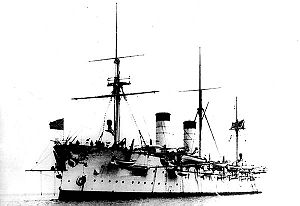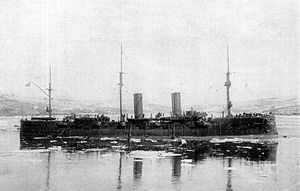Russian cruiser Rurik (1892)

| |
| History | |
|---|---|
| Laid down | 19 May 1890 |
| Launched | 22 October 1892 |
| Commissioned | May 1895 |
| Fate | Scuttled - 14 August1904 |
| General characteristics | |
| Displacement | list error: <br /> list (help) As designed: 10,993 As built: 11,960 tons |
| Length | 412 feet (126 m) |
| Beam | 67 feet (20 m) |
| Draught | 26 feet (7.9 m) |
| Propulsion | list error: <br /> list (help) 2-shaft VTE 13,250 indicated horsepower (9,880 kW) 8 cylindrical boilers |
| Speed | 18 knots (33 km/h) |
| Range | 6,700 nautical miles (12,400 km) at 10 knots (19 km/h) |
| Complement | 719 officers and crewmen |
| Armament | list error: <br /> list (help) 4 x 8 in (203 mm) / 35 cal 16 × 6 in (152 mm) / 45 cal 6 x 4.72 in (120 mm) / 45 cal quick-firing 6 x 47 mm / 43 cal 10 x 37 mm / 23 cal 6 × 15 in (381 mm) torpedo tubes |
| Armour | list error: <br /> list (help) 8 to 12 inch (200 to 300 mm) on the sides 2 to 3 inch (50 to 75 mm) on deck 6 inch (150 mm) on the conning tower |
The Rurik (Рюрик) was an armoured cruiser built for the Imperial Russian Navy in 1895. She was named in honour of Rurik, the semi-legendary founder of ancient Russia. She was sunk at the battle of Ulsan in the Russo-Japanese war.
Design and construction
The Russian Navy, by the end of the 19th century required a cruiser capable of undertaking long cruises into foreign waters for the purpose of destroying commercial vessels, especially if war was to occur between Russia and Great Britain. Russian admiral Ivan Shestakov submitted the design of the Rurik to the Baltic Works for construction, bypassing the normal procedure of submitting the design to the Naval Technical Committee (MTK). The original specifications for the vessel, as submitted by Shestakov, are currently lost[1], but presumably Shestakov intended the ship to be able to travel from "the Baltic to Vladivostok without recoaling en route"[1]. It appears that Shestakov wanted a design similar to the Pamiat Azova and such a design was submitted via a constructor from the Baltic Works to the MTK[1].
That design, a 9,000-ton, 8 inch belted cruiser, was rejected by the MTK. It is more likely that the design was rejected because of tension between Shestakov and the MTK and the MTK and the General Admiral of the Navy, Grand Duke Alexei Alexandrovich, rather than technical issues with the design[1]. The submitted design called for a long warship (over 400 ft) and had a design endurance of 20,000 nautical miles (37,000 km). Shestakov was unable, however, to fight for the submitted design, as he died in December 1888.
Shestakov's successor, Chikhachev, had excellent relations with the MTK board, and the Baltic Works design was quickly rejected. The MTK design which followed was a 10,000-ton vessel with a 10 inch belt and with an operational speed and range of 18 knots (33 km/h) and 10,000 nautical miles (20,000 km) respectively[1]. The Rurik would also sport a complete barque rig. Construction began in 1890 after powerplant issues were solved by the technical designers at the Baltic Works.
As plans and designs of the Rurik were being finalized, rumors began floating as to the exact nature of the vessel. In particular, Britain became extremely nervous about the new cruiser, fearing greatly for her large commercial fleet which she depended on. The British press "fueled anxiety to the point where it approached paranoia"[1]
Completed in 1895, the Rurik stunned the Royal Navy. With only a top speed of 18.7 knots (34.6 km/h) in good conditions[1], the barque rig cruiser looked obsolete compared to new British warships being developed and built. While there was a heavy armament of four 8-inch (203 mm) guns and 16 6-inch (152 mm) guns, along with a quartet of 15-inch (381 mm) torpedo tubes, the armour for the Rurik was light, with only an average 2.5 inches on the decks and an average 10 inches on the sides using nickel steel plate.
Service history

After her commissioning, the Rurik headed for the Russian Pacific Squadron based at Vladivostok. Admiral Dubasov, who commanded the Pacific Squadron, recommended various modifications to the ship after a short period of service, including reboilering and the removal of the ship's rigging[1]. The reboilering project never got off the ground, but the amount of rigging was cut down significantly.
When the Russo-Japanese War broke out in 1904, the Rurik and the other cruisers of the Pacific Squadron, the Rossia, the Gromoboy, and the Bogatyr, were all charged with seeking out and destroying Japanese merchant vessels. By August 1904, only one ship had been sunk and the Japanese Army had moved siege artillery close enough to shell the main Russian port in the Pacific, Port Arthur. The siege of Port Arthur kept a number of Russian naval vessels tied up inside the port, and several attempts at breakouts occurred, all of which were supposed to be supported by the Pacific Squadron.
On 14 August, three of the four Pacific Squadron cruisers sortied to Port Arthur (the Bogatyr having received damage due to grounding[1]). They were met by a squadron of Japanese warships which resulted in the battle off Ulsan. Early in the engagement, the weaker Rurik was hit by Japanese fire and was slowed, splitting it from the rest of the Russian ships. The Russian Admiral Karl Yessen attempted to provide cover for the ship, but was pushed back by the Japanese cruisers. As the Russian ships withdrew, the Rurik was set upon by several Japanese cruisers. Rather than surrender the ship to the Japanese, the senior surviving officer, one Lieutenant Ivanov, ordered the ship to be scuttled. The Japanese picked up about 625 survivors, the rest perishing in the engagement.
The other two Russian cruisers escaped without incident.
Legacy
Despite her obsolete physical appearance, with the barque rigging and unprotected guns, the Rurik performed surprisingly well at Ulsan. The ship was quite possibly responsible for the escape of the other two Russian cruisers, though that can also be attributed to the Japanese indecisiveness at the battle[1]. While the Rurik's presence was decisive at Ulsan, the Russians subsequently wasted the second chance they had at using the Rossia and the Gromoboi. The Rossia joined the Bogatyr with grounding damage and the Gromoboi never sortied for the rest of the war.
Outside the context of the Russo-Japanese War, the Rurik's only other influence would be on the Royal Navy. The Royal Navy built the large and expensive Powerful-class protected cruisers specifically to deal with what the Rurik was rumoured to be: a fast, heavily armed cruiser that would prey off merchant vessels.
See also
- Rurik (1906) - Russian armoured cruiser built by Vickers
- Russian frigate Rurik (1851)
Notes
References
- Anthony Preston, The World's Worst Warships. Conway Maritime Press 2002 ISBN 0-85177-754-6
- Stephen McLaughlin, From Ruirik to Ruirik Russia's Armoured Cruisers in Warship 1999-2000. Conway's Maritime Press
- Peter Brook, Armoured Cruiser vs Armoured Cruiser, Ulsan 14 August 1904, in Warship 2000-2001 Conway's Maritime Press
- battleships-cruisers.co.uk
